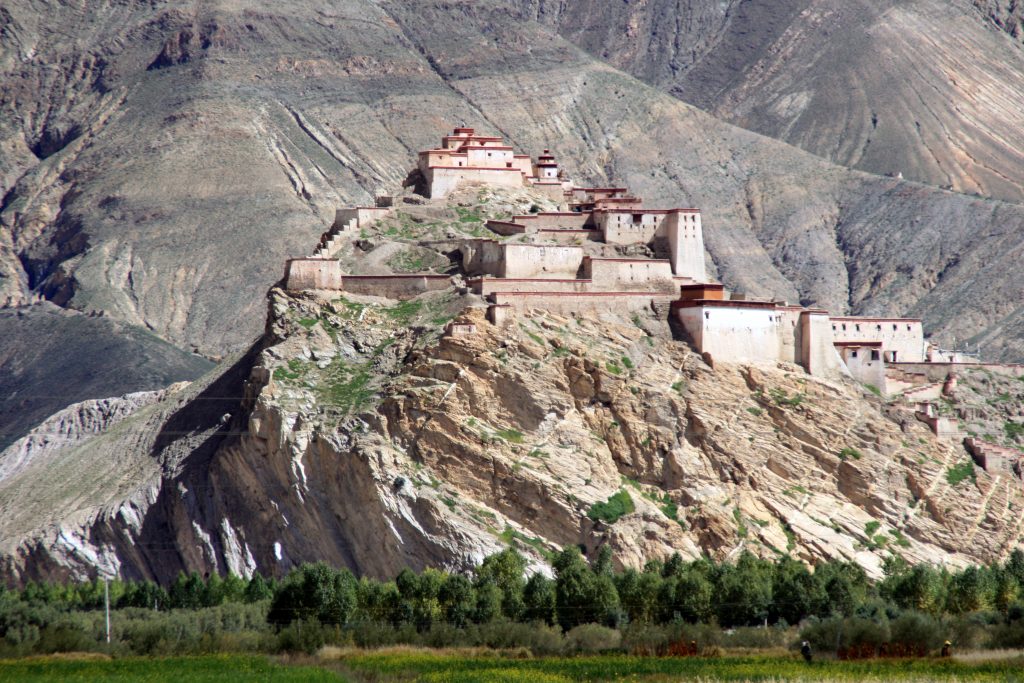
Getting to Gyantse: the beating heart of Tibet
Gyantse and the Kumbum are the beating heart of Tibet and Tibetan culture. We visited Gyantse on a three-day trip by mini-van that also included Shalu monastery and the town of Shigatse. We reached Gyantse after a long eight-hour ride, made even longer by our detour to see Yamdrok-Tso Lake.

From the Kamba-La Pass at 4794 metres, there are spectacular views over the turquoise waters of the lake. However, due to road works (expected to be finished next year), it wasn’t possible to continue along the old road to Gyantse, so we had to turn back and rejoin the new road.

The final part of the journey took us through fertile and idyllic fields, full of grazing animals and harvesting farmers.


Approaching Gyantse and seeing the Fort
The approach to Gyantse is truly spectacular: the ruins of the fortress, the Dzong, destroyed by Younghusband and his British troops, set on a steep, rocky hill, stand out against the azure sky and the golden roofs of the monastery gleam in the sun.

Gyantse itself is rather more prosaic; it is basically a scruffy one-street town (2007: has expanded now) with an interesting, traditional Tibetan quarter.

We had just enough time to visit the Pelkhor Chöde Monastery complex, situated dramatically at the foot of the barren mountains and surrounded by a brown wall.

The Kumbum
Gyantse’s highlight is the Kumbum, an 8 storey chorten, topped by a golden roof and umbrella, apparently the best- preserved structure of this kind in Tibet.

The 8 floors contain 108 chapels, all covered in frescoes and many holding statues. The outside is painted a dazzling white and decorated with colourful stucco, as well as four huge pairs of eyes, which survey the surrounding countryside.

Though most of the frescoes are hidden in darkness and many are damaged, we managed to make out some frightening demons, adorned with necklaces of skulls, fine many-armed Buddhas and delicate maidens.

The chapels which are set at the corners are the best, as they are two storeys’ high and contain a variety of large statues.

On the sixth floor we emerged onto an open platform, level with the painted eyes, from which we could observe the other monastic buildings, the walls, the mountains, as well as the Tibetan old town.

Gyantse Fort
The next day we visited the old fortress, or Dzong, and explored the Tibetan quarter.

As we mentioned before, most of the Dzong is in ruins; thanks to Younghusband and his men who came riding in from Sikkim to ‘open’ Tibet to trade… They are, however, quite atmospheric ruins. One of the highlights is a grey memorial stone with the curious inscription ‘Jump off the cliff’.

However, this isn’t an exhortation to visitors, but rather a commemoration of an act of bravery committed by the outnumbered defenders.

Gyantse Old Town
The old Tibetan quarter, lying at the foot of the fortress, is another gem that takes you right back in time.

Along the main street, there are placid cows chewing the cud in front of every household, while pigs and sheep rummage around in the gutters.

People gather at the communal pumps to draw water, wash their clothes, hair or rinse dyed strings of sheep’s wool.

Inside the traditional stone houses, Tibetan ladies work the heavy wooden looms to weave cloth or colourful Tibetan carpets.

A peaceful, mellow village ambience reigns and life continues, unhurriedly, as it always has done.

Gyantse Practicalities:

Accommodation:

We stayed at the Jianzang hotel which lies on the main street of the modern part of town (Yingxiong Nanlu) and is certainly one of the nicest places we stayed at in the whole of Tibet, or even China. The hotel is embellished with bright, colourful murals and lovely potted plants and flowers, while rooms are large, clean and comfy. We paid 180 Yuan for a double with bathroom, though there were cheaper rooms and dorms as well. The hotel also has its own rooftop restaurant and staff are very friendly.

Food:
You will have no trouble finding several places to eat along the same main street. The Yak bar and restaurant, for which you have to go upstairs, is a pleasant, laid-back place with Tibetan sofas and low tables, specialising in western-style food such as chips, pizzas and burgers. There is a large Chinese restaurant, a few doors away and identified by a green sign, where we had an excellent meal.

